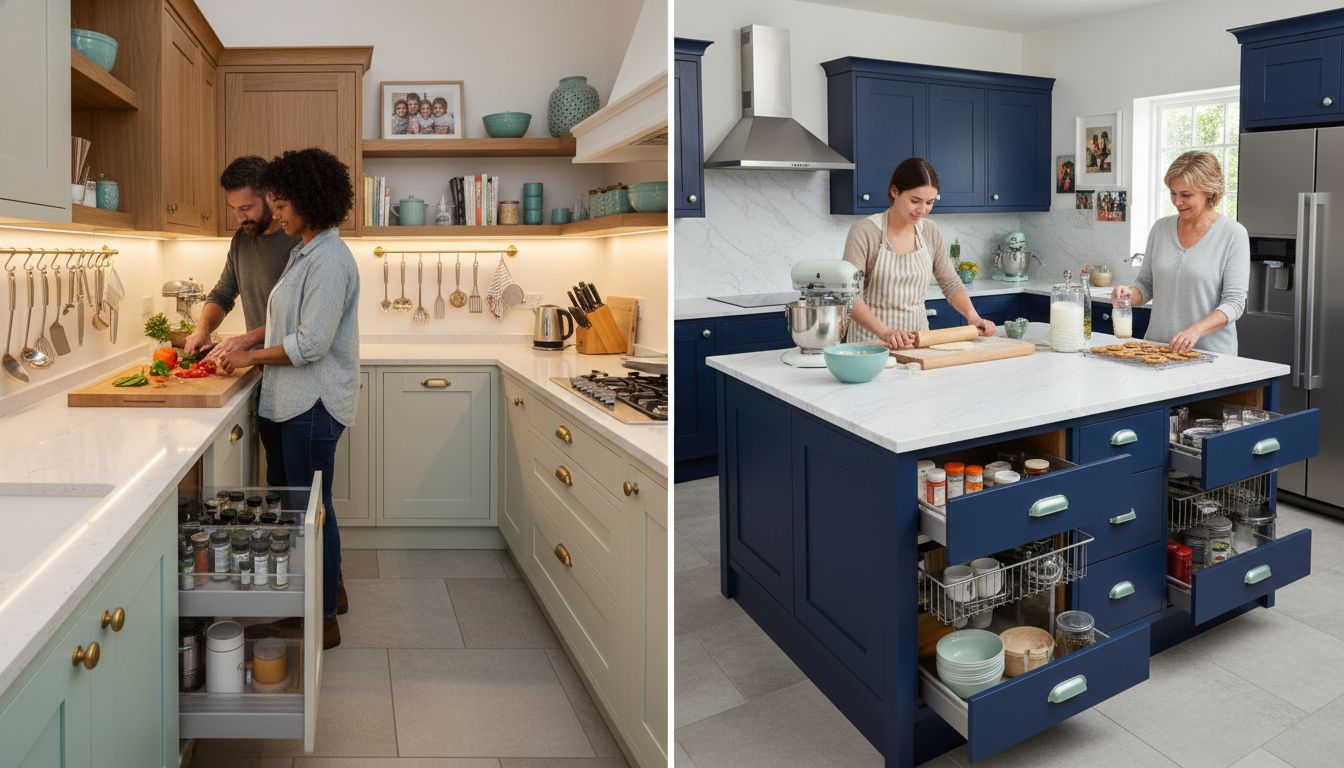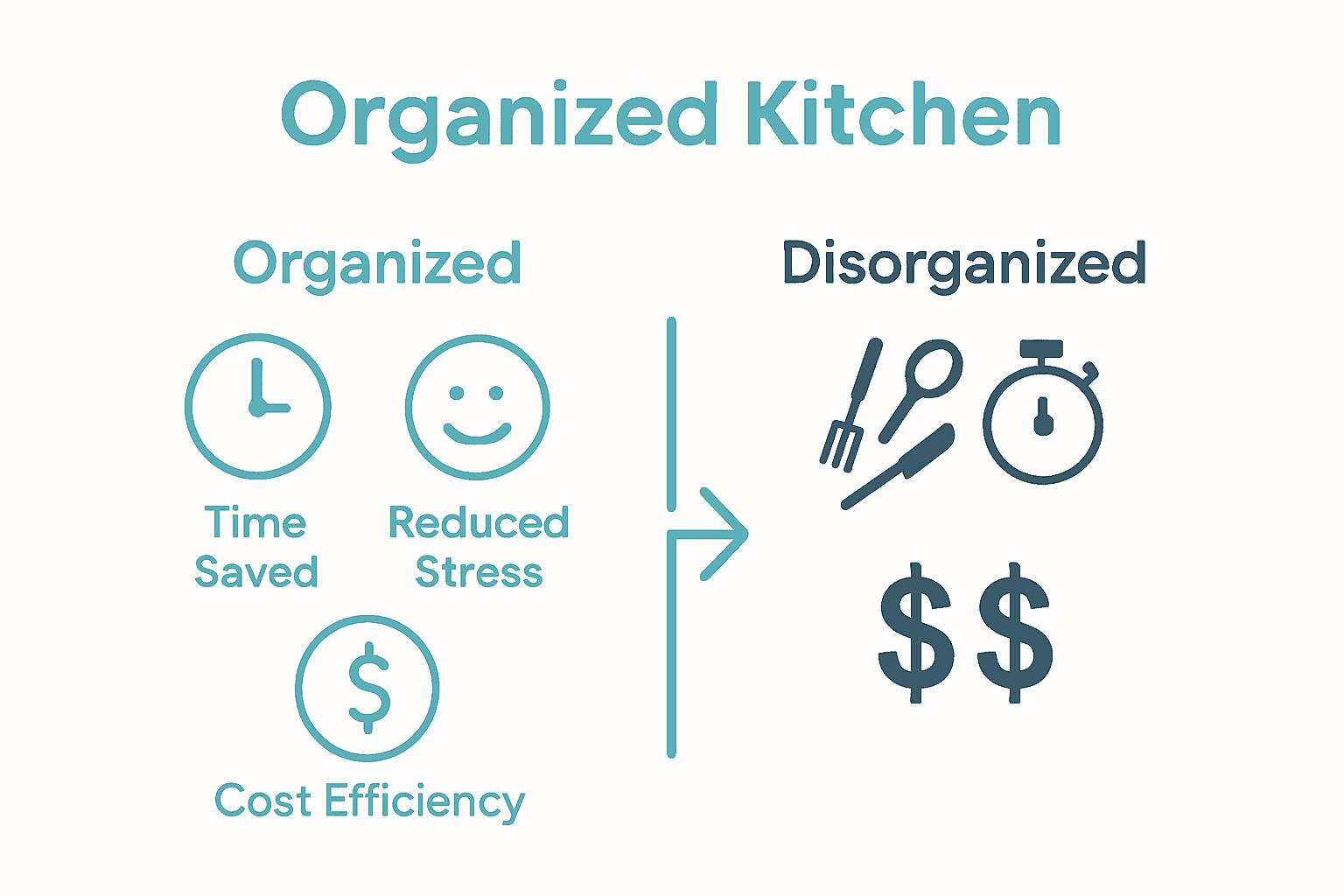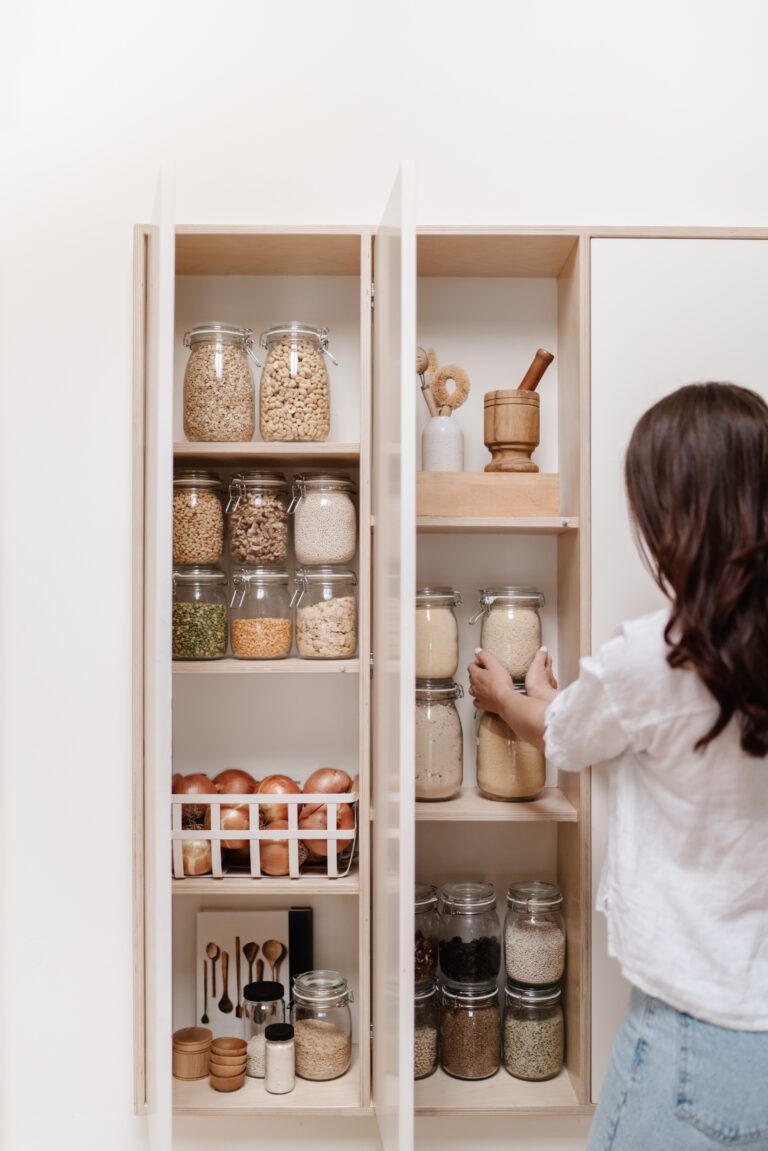Why Organize Your Kitchen: Essential Guide
Did you know that an efficiently organized kitchen can save you up to 30 percent of your time during meal prep and cleanup? Most people spend far too many hours searching for lost utensils or struggling with cluttered cabinets. Smart kitchen organization has become essential for anyone craving a smoother, more enjoyable cooking experience. Discover how the right arrangement can reduce stress, save money, and turn mealtime into a pleasure rather than a chore.
Table of Contents
- Defining Kitchen Organization And Its Purpose
- Types Of Kitchen Organization Systems
- Key Benefits Of An Organized Kitchen
- How Organization Impacts Time And Costs
- Common Pitfalls And What To Avoid
Key Takeaways
| Point | Details |
|---|---|
| Purpose of Kitchen Organization | A well-organized kitchen maximizes convenience and efficiency, reducing time and effort in food preparation. |
| Effective Layouts | Utilizing L-shaped or U-shaped layouts improves workflow and minimizes unnecessary movement for a more ergonomic environment. |
| Time and Cost Efficiency | Streamlined organization saves time on meal prep and reduces costs by minimizing duplicate purchases and food waste. |
| Avoiding Common Pitfalls | Focus on practical, intuitive systems that support your cooking habits; avoid over-complexity and ignore aesthetics that don’t serve functionality. |
Defining Kitchen Organization And Its Purpose
Kitchen organization is more than just arranging your pots and pans. It’s a strategic approach to making your cooking and food preparation space work smarter, not harder. According to research from the National Agricultural Library, the primary purpose of kitchen organization is to maximize convenience and efficiency for the homemaker, ultimately reducing the time and work involved in daily kitchen activities.
At its core, kitchen organization involves creating a systematic setup where every item has a designated place and every task has an optimal workflow. Much like professional kitchen environments where tasks are carefully assigned, your home kitchen can benefit from similar principles. Students Academic Research suggests that effective organization is influenced by several key factors:
- Your specific cooking style
- Available kitchen space
- Types of meals you frequently prepare
- Number of people using the kitchen
Think of kitchen organization as creating a personal culinary command center. When done right, it transforms your kitchen from a chaotic space into an efficient, enjoyable area where cooking becomes less of a chore and more of a pleasure. Kitchen Organization Essentials can help you dive deeper into creating your perfect kitchen workflow.
Ultimately, great kitchen organization isn’t about perfection – it’s about creating a space that works seamlessly for you and your family’s unique needs. By understanding the purpose and principles of kitchen organization, you’ll be well on your way to a more streamlined, stress-free cooking experience.
Types Of Kitchen Organization Systems
Kitchen organization isn’t one-size-fits-all. Different kitchen layouts and systems can dramatically improve your cooking experience and home efficiency. Understanding the Kitchen Organization Guide for Better Cooking reveals that strategic kitchen design can transform how you work and move in your culinary space.
Two primary kitchen layout systems stand out for their efficiency. According to the National Agricultural Library, the L-shaped kitchen arrangement is specifically designed to reduce unnecessary movement. This layout minimizes walking, stooping, and stretching, creating a more ergonomic cooking environment. Key benefits include:
- Reduced physical strain
- Improved workflow
- Better use of corner spaces
- Enhanced cooking efficiency
Alternatively, the U-shaped kitchen layout offers another compelling organization system. Research from the National Agricultural Library highlights that this compact work center prevents household traffic from interrupting your cooking process. By forming a complete loop around the cook, it creates a focused and streamlined workspace.

Beyond these physical layouts, kitchen organization systems can also be categorized by storage approaches. These might include zone-based organizing, vertical storage solutions, modular systems, and color-coded storage methods. The goal remains consistent: creating a space that works intuitively for you and makes cooking a more enjoyable, less stressful experience.
Here’s a comparison of key kitchen organization systems and their benefits:
| Layout/System Type | Description | Main Benefits |
|---|---|---|
| L-Shaped Layout | Two adjacent walls forming an “L” shape | Reduces movement Uses corners well Improves workflow |
| U-Shaped Layout | Cabinets and counters on three sides | Prevents traffic Creates efficient work zone |
| Zone-Based Organizing | Grouping items by task or activity zones | Faster prep Less searching Intuitive workflow |
| Vertical Storage | Shelves and racks that use vertical space | Maximizes storage Saves space Keeps counters clear |
Key Benefits Of An Organized Kitchen
An organized kitchen is more than just a neat space – it’s a game-changer for your daily life and overall home efficiency. Why Organize Your Kitchen: Benefits and Impact reveals that strategic kitchen organization can transform how you cook, eat, and live.
According to research from the National Agricultural Library, an efficiently arranged kitchen can dramatically improve productivity. This means you can accomplish more with the same amount of effort, essentially reducing your kitchen labor costs and saving precious time. The benefits extend far beyond just looking good:
- Reduced stress during meal preparation
- Faster cooking and cleaning processes
- Less time searching for utensils and ingredients
- Improved meal planning capabilities
Furthermore, National Agricultural Library research highlights the importance of step-saving kitchen designs. These layouts are meticulously crafted to minimize unnecessary movement, making your cooking experience smoother and more enjoyable. By strategically placing items and creating intuitive workflows, you’ll find yourself moving more efficiently and spending less energy on mundane tasks.
Ultimately, an organized kitchen is an investment in your daily quality of life. It’s not just about aesthetics, but about creating a functional space that supports your lifestyle, reduces mental clutter, and makes cooking feel less like a chore and more like a joy.
 The time and energy you save can be redirected towards what truly matters – enjoying delicious meals and spending quality time with your loved ones.
The time and energy you save can be redirected towards what truly matters – enjoying delicious meals and spending quality time with your loved ones.
How Organization Impacts Time And Costs
Kitchen organization is more than an aesthetic choice – it’s a strategic approach to managing your most valuable resources: time and money. How to Organize Kitchen for Maximum Efficiency demonstrates that smart organization can transform your cooking experience from chaotic to streamlined.
Research from the National Agricultural Library reveals that streamlining kitchen layout can significantly increase productivity without requiring additional workers. This means you can accomplish more with the same amount of effort, effectively reducing labor costs in your home kitchen. The financial implications are substantial:
- Fewer unnecessary purchases of duplicate items
- Reduced food waste through better inventory management
- Lower energy consumption from efficient workflow
- Minimized eating out due to easier meal preparation
Additionally, National Agricultural Library research highlights the importance of step-saving kitchen designs. These intelligent layouts are engineered to minimize unnecessary movement, directly translating to time savings. By strategically positioning items and creating intuitive work zones, you’re essentially designing a personal efficiency machine that cuts down on wasted minutes and unnecessary effort.
Think of kitchen organization as an investment with compound returns. Every minute you save, every unnecessary step you eliminate, adds up to significant time and cost savings over weeks, months, and years. It’s not just about having a tidy kitchen – it’s about creating a system that works for you, saving you money and giving you back precious time to enjoy life beyond the kitchen walls.
Common Pitfalls And What To Avoid
Kitchen organization sounds simple, but there are numerous traps that can derail your efforts. 10 Simple Steps to Declutter Your Kitchen warns that without a strategic approach, your organizational attempts can quickly become counterproductive.
According to the National Agricultural Library, inefficient kitchen layouts can dramatically decrease productivity and increase hidden labor costs. The most common organizational pitfalls include:
- Over-complicated storage systems
- Ignoring workflow patterns
- Purchasing unnecessary organizational tools
- Failing to regularly reassess and adjust systems
- Overcrowding storage spaces
National Agricultural Library research emphasizes that neglecting step-saving designs is perhaps the most critical mistake. Many people create organizational systems that look good on paper but create more work in real-life scenarios. The key is designing a system that naturally supports your actual cooking and food preparation habits.
Remember, the goal of kitchen organization isn’t perfection – it’s creating a functional space that makes your life easier. Don’t get caught up in Instagram-worthy setups that look great but don’t work for your specific needs. Your kitchen should be a practical, comfortable space that reduces stress and makes cooking enjoyable, not an additional source of frustration.
Transform Your Kitchen Into a Stress-Free Zone Today
Are you tired of feeling overwhelmed by clutter and inefficiency in your cooking space The article “Why Organize Your Kitchen” highlights common challenges like wasted time searching for utensils and increased kitchen labor costs These pain points slow down meal preparation and add stress to your daily routine but they do not have to define your kitchen experience
At Simple Neat Home we understand how crucial it is to create a well-organized kitchen that works seamlessly for your unique needs Don’t let inefficient layouts or overcrowded spaces drain your energy Discover practical tips and smart solutions in our Organization Archives and explore focused advice on kitchen improvement in our Kitchens Archives. Reclaim control now and start transforming your kitchen into a smooth, enjoyable, and time-saving environment. Your calmer kitchen awaits so why wait any longer
Frequently Asked Questions
What is kitchen organization and why is it important?
Kitchen organization involves creating a systematic setup where every item has a designated place and every task has an optimal workflow. It’s important because it maximizes convenience and efficiency, ultimately reducing time and effort in daily cooking activities.
What are the benefits of having an organized kitchen?
An organized kitchen reduces stress during meal preparation, speeds up cooking and cleaning processes, minimizes the time spent searching for utensils and ingredients, and improves overall meal planning capabilities.
What are the different types of kitchen organization systems?
There are several types of kitchen organization systems, including the L-shaped and U-shaped layouts, zone-based organizing, vertical storage solutions, and modular systems. Each system has unique benefits tailored to improve workflow and efficiency in the kitchen.
How can kitchen organization impact time and cost?
Effective kitchen organization can increase productivity, reducing labor costs by minimizing unnecessary movement and streamlining workflows. This often results in reduced spending on duplicate items, lower food waste, and less reliance on takeout, ultimately saving both time and money.
Recommended
- Kitchen Organization Essentials | Simple Neat Home
- Understanding the Kitchen Organization Guide for Better Cooking | Simple Neat Home
- Eco Friendly Cleaning Tips For Busy European Mums – The Zoofamily







